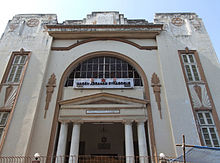Beni Israel
The Beni Israel (also Bene Israel, Benai Israel, B'nai Israel or Bani Israel , "Sons of Israel") are a group of Jews in India who lived mainly in Mumbai and the surrounding area of the city until the mid-20th century Konkan region as far as Karachi in the north. Their language is the Marathi spoken in Maharashtra state , while the Cochin Jews in southern India speak Malayalam .
The Beni Israel claim to be descended from Jews who died after the persecutions of the 2nd century BC. Fled into Galilee . The Beni Israel resemble the non-Jewish people of the Marathas in appearance and customs, which suggests a mixture of Jews with Indians. The Beni Israel obey the Jewish dietary laws , circumcision, and keep the Sabbath day of rest.
The Beni Israel say their ancestors were oil pressers in Galilee and came from shipwreck survivors . In the 18th century they were "discovered" by traders from Baghdad . At that time the Beni Israel practiced only a few outward forms of Judaism (because of this they were recognized as Jews) and had no scholars of their own. Their religion also showed Christian-Islamic influences. Scholars from Baghdad and Kochi then taught them the main directions of 18th and 19th century Judaism.
Jewish traders from Europe traveled to India in the Middle Ages, but it is not clear whether they settled permanently in southern Asia. The first reliable evidence for Jews in India comes from the 11th century. It is certain that the first settlements were along the west coast. Abraham ibn Daud's reference to Jews in India from the 12th century is rather vague. There is no evidence for the next few centuries. A source from the 16th century is the Dutch merchant Jan Huygen van Linschoten , who reports from 1579 to 1592 that there were large numbers of Muslims and Jews in Cochin , Goa and inland. In the following, Pieter van den Broecke reports accordingly on Jews in Gujarat between 1621 and 1630 . 6,000 Beni Israel are believed to be 6,000 by the 1830s, 10,000 by the turn of the century, and 20,000 by 1948, when they reached the summit in India. Since then, the population in India has fallen to below 5,000 (mainly because of emigration to Israel ). Some scholars (Afzal Khan Khatak, Hafez Rahmat Khan, Sir William Jones and others) hold the theory that the Beni Israel became the Pashtun people .

The Beni Israel are just one group within the Jews of India. Another are the Baghdadi ("from Baghdad [originating]"), as Jews from the Middle East, mainly from Iraq , are called, who moved to India at the beginning of the 18th century. Up until the emigration of most Jews to Israel in the course of India's independence in 1948, the Baghdadi emphasized their “non-Indian” Judaism and, like the British Jews, questioned the Jewishness of the Beni Israel. In 1964 the Israeli rabbinate declared that the Beni Israel were full Jews in the sense of the Halacha .
For their worship services, the Beni Israel adopted the devotional singing style Kirtan from the Hindus , in which they often recite the Joseph story ( kirtan Yosef ).
In Israel, the majority of the Beni Israel live in some settlements as communities, which means that they have preserved many of their Indian cultural traditions. These include Indian marriage customs and the sari , which most women wear at least as festive clothing. Their main traditional musical instruments are the Indian harmonium and the bulbultarang keyboard zither, also from India .
literature
- Shirley Berry Isenberg: India's Bene Israel: A Comprehensive Inquiry and Sourcebook. Judah L Magnes Museum, 1989, ISBN 0-943376-27-0
Web links
- www.jewishencyclopedia.com (English)
- www.infoplease.com (English)
Individual evidence
- ↑ Ishrat Alam: Jewish Merchants in the Mughal Empire. In: Proceedings of the Indian History Congress, Vol. 6, 2004, pp. 267-276, here p. 267
- ↑ Mitch Numark: Constructing a Jewish Nation in Colonial India: History, Narratives of Discent, and the Vocabulary of Modernity. In: Jewish Social Studies, New Series, Vol. 7, No. 2, Winter 2001, pp. 89–113, here p. 89
- ^ Judith Cohen: Jewish Music. IV: Eastern Diaspora (14th – 19th centuries). 3. Oriental communities. b. India (Bene Israel, Cochin). In: MGG Online, November 2016
- ^ Rina Krut Moskovich: The Role of Music in the Liturgy of Emigrant Jews from Bombay: The Morning Prayer for the Three Festivals. In: Asian Music, Vol. 17, No. 2 (Music in the Ethnic Communities of Israel) Spring – Summer 1986, pp. 88–107, here p. 90
